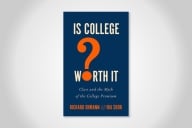You have /5 articles left.
Sign up for a free account or log in.
As total student debt passed $1 trillion last year, more than 35 percent of repaying borrowers under age 30 were at least 90 days late on their payments. The first three months of 2013 were the worst on record for student loan defaults. A college education still pays, but rising tuition, low graduation rates and burgeoning debt levels are pushing postsecondary credentials out of reach for too many students. Meanwhile, the government is expecting to earn a $34 billion dollar profit on federal loans next year.
Congress is about to make things worse. Last spring, students fought and won a battle to prevent interest rates on subsidized Stafford loans, loans with lower interest rates on which the government pays the interest while students are enrolled, from doubling. Yet Congress only fixed the problem for a year. If our leaders in Washington fail to act again, over 7 million students would see their interest rates jump from 3.4 percent to 6.8 percent on July 1. That adds $1,000 to repayment per year of school for someone who borrows the maximum amount each year – an extra $4,000 for a student who graduates in 4 years. Students are fed up with manufactured crises and Band-Aid policies. We need a comprehensive solution that permanently fixes how the federal government sets interest rates for student loans. But the current long-term proposals fall far short.
Proposals Fail to Solve the Problem
One leading reform idea, embraced by both Senate Republicans and President Obama, would replace the current system, fixed interest rates set by Congress, with rates that vary with market conditions but are fixed over the life of the loan – like a mortgage. Students would pay less when overall interest rates are low, and more when overall interest rates are high. The rate would change over time, with no need for Congress to get involved. Allowing for some flexibility would be fairer to borrowers and provide the kind of comprehensive long-term fix that students need. Overall interest rates are currently at historic lows: the federal government can borrow for less than 2 percent on a 10-year Treasury note, but federal loans to students are set at rates ranging from 3.4 percent all the way up to 7.9 percent.
With a market-based rate, though, comes the risk that interest rates will shoot upward. If Treasury rates were to rise to say, 10 percent -- which happened in the 1980s -- not only would this substantially increase costs for students, but it could deter students from going to college at all. A market-based rate with no cap is simply wrong for students.
Which is why the devil is in the details. Senate Republicans, who want to use student borrowers to pay off the deficit, start with a rate set at the 10-year Treasury bill plus 3 percent, a rate that will inevitably rise further with the market. They would also allow interest to grow while students are in school, fueling more student debt, and using the money to reduce the deficit. Previous rounds of deficit reduction followed by sequestration have already slashed the federal education budget. Students need reform that makes college more affordable, not less.
The president’s budget proposal is also disappointing. It changes rates to a market-based rate, but provides no cap on how those rates could go. This approach keeps rates low now but pays for it by letting rates rise later. It also subjects those rates to the whims of the market – who could have predicted today’s low rates?
A better approach would combine a market-based rate with a strong cap and have borrowers pay back loans based on their income. Under this model, interest rates would track market conditions when issued, but would be fixed over the life of the loan.
The fixed rates and a strong cap would balance flexibility with the need to provide certainty to students. Borrowers would know their expected monthly payment as soon as they took out their loans. A dramatic interest rate spike would never seriously threaten educational investment. Finally, the annual adjustment of a market-based fixed rate removes Congress from the rate setting process -- something everyone can appreciate.
A change to interest rates alone, though, will not curtail rising defaults in a tough economy. That is why we need broader reform to the student loan system. We need better counseling, better loan servicing, and importantly, a simple system that puts students into income-based repayment (IBR). By having students pay back their loans based on what they earn, we would ensure that students graduating in tough economic times would not pay more than they could afford. IBR does not replace an interest rate cap because it does not limit total debt owed or the time required to pay it back. Rather, it limits monthly payment amounts, an essential tool for stemming the default tide that ruins credit ratings and livelihoods.
Finally, we need comprehensive federal and state reforms that will truly address the underlying driver of student debt -- the rapidly rising cost of college.
Last year Congress worked together to avoid a self-inflicted crisis only to face another one 12 months later. We need to address rising college costs and increase school accountability, but we also face a looming deadline to take action on student loans and ensure an affordable, stable system for years to come. And if comprehensive student loan reform proves politically impossible, we must at least come to a short-term agreement that keeps rates low for students and leads us on the path toward that long-term solution.
As we approach the July 1 deadline, one thing is clear: students can’t afford for Congress to default on its responsibilities.








